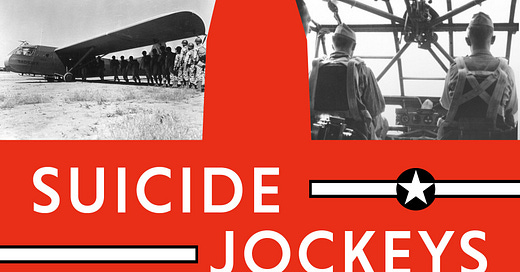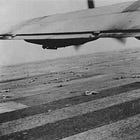In the past postings and podcast I followed up on spoke about the seemingly conflicting orders World War II glider pilots were under once they oversaw the overloading of their cargo or glider infantry on the landing zones. To quickly reiterate, the WWII gliders purpose was to transport men and cargo behind enemy lines. The glider was new a new WWII aircraft. Once they landed the glider pilots were to report to a command post. This was not always possible depending upon the situation on the ground. At times they fought with the airborne if there was chaos at the command post, the command post had been moved, the glider pilots were pinned down or skirting German forces. Somer landed outside their LZs and had to make their way their or escape the area on their own or with the help of the underground organization. Troop Carrier Command stressed the glider pilots main focus was to get back to base as quickly as possible. In essence they had to use their own judgment. Get to the command post or evacuate back to their base. I discuss all of this in the podcast After Reports of MARKET - GARDEN - the Generals.
In this post I would like to look at the individual glider pilots perspective and we can see that it is not as cut and dry as has been made out by writers. Many reports have greatly oversimplified and generalized a complex battle situation. Although the command will look at the larger picture to make decisions we have the liberty of focusing in on the parts that made the whole. Following are a few reports from MARKET. Spelling and corrections have not been made. I will add very little since these reports speak for themselves especially if you have read Suicide Jockeys: The Making of the WWII Combat Glider Pilot. (QR Code below)
This report is from a glider pilot in the 313th TCG but unfortunately I cannot make out his name:
“After landing I assembled my troops in a safety area until the other glider has landed. Then assisted them in unloading and then processed to the assembly point. I was then told to fall in and move with the troops in the regimental C.P. After several hours of march I was told by an A/B officer that the GLIDER PILOTS were to report in several miles to the rear. I hiked back and talked to some other A/B officers who told me there was nothing for me to do, and if I would hang around they would evacuate me as soon as they could or I could evacuate myself which I did. I left the L.Z. area at 1000 hours Sept. 24 and arrived in Brussels at 1600 hours Sept. 25th on TTC plane and arrived at the base station 484 1400 hrs. the same date.”
From F/O James Hopkins:
“At the time I landed there was only 1 glider on the LZ. I made a landing without damaging my glider or my load. After finding out I was on the wrong LZ, I turned my load, which was a 105 mm Howitzer and 54 rounds of ammunition over to the proper authorities. After being told where to assemble, I dug in and stated with some other Glider Pilots that night and the following day. About dusk on Monday night 8 JU88s flew over the LZ, but dropped no bombs. Early Tuesday morning some elements of the British armour broke through and went past the LZ. Late Tuesday evening we moved out bivouac area to the North side of the LZ. Just after we dug in at our new position German bombers came over and attempted to bomb the bridge which was a mile south of the LZ. Raid unsuccessful. However, early the following morning German tanks succeeded in knocking out the bridge. Thursday morning I was evacuated with a British convoy back to Belgium. After the bridge was repaired I stayed at Brussels until Sunday. Went to the nearest airfield and caught a ride back to Cottesmore. From here I got a jeep ride back to station 484.”
From F/O Clarence Bean:
“ Troop Carrier Command officer at B56 closed and gp [glider pilots] found difficulty in getting evacuated, finally hitching ride back in British plane.”
From F/O Randolph:
“Tow ship was hit near Boxtel and went down. Immediately cut and looked for a landing field. My first choice was a large field was found to be unsatisfactory because of enemy small arms firing at us, so after turning around made landing in a small field further on. No enemy fire at this field. After landing we hid out for a day and a night with the help of the Dutch people. The Dutch people were very friendly and saw that we didn’t go hungry. They fed us and kept us hid from the enemy and then they led us to our friendly forces, which were the 101st Airborne Division. After making contact with the 101st Airborne Division we were carried further back to the road to a hospital where the medic that I carried was put to work in the hospital until later where they could meet up with their own Division which was the 82nd Airborne Division. I left them the next morning which was September 20th starting back for Brussels. I was delayed enroute because all the traffic was going towards the front lines. After walking and hitch hiking and being shelled I made it to Eindhoven, Holland in the late afternoon where I spent the night. After sleeping in a bombed out hotel I proceeded the next morning for Brussels. After hitch hiking all day I reached Brussels at 1600 on the 21st of September. I immediately proceeded to the air post where I arranged transportation back to the 53rd Troop Carrier Wing. After being grounded for the night I got a plane for the 52nd Wing. We landed at Cottesmore in the morning and in the afternoon I got transportation back to my home base, at 1600 on the 22nd of September, 1944.”
These are just a very few of the individual experiences of the glider pilots in MARKET from landing to evacuation. From just these few it is obvious that every glider pilot acted within the specific circumstances they found themselves in. Although there are many more that I will post over time these are a good representative sample of what glider pilots faced in this particular mission.
Of note is that glider pilots were not the only service members to fight with units other than their own. Specifically the medic mentioned in F/O Randolph’s fought with the 101st Airborne although he was assigned to the 82nd Airborne.
Next time we will head for the foxholes.






